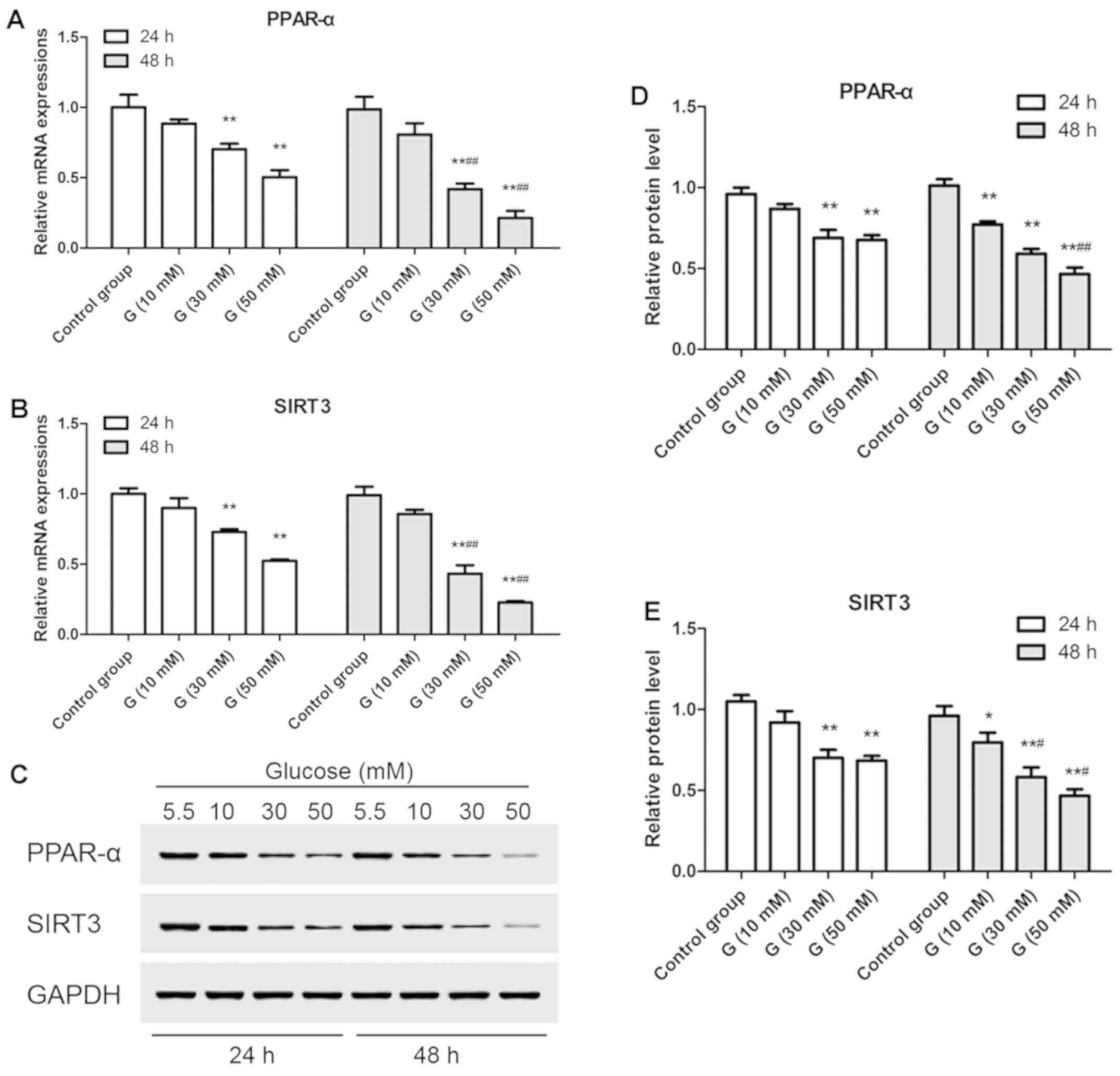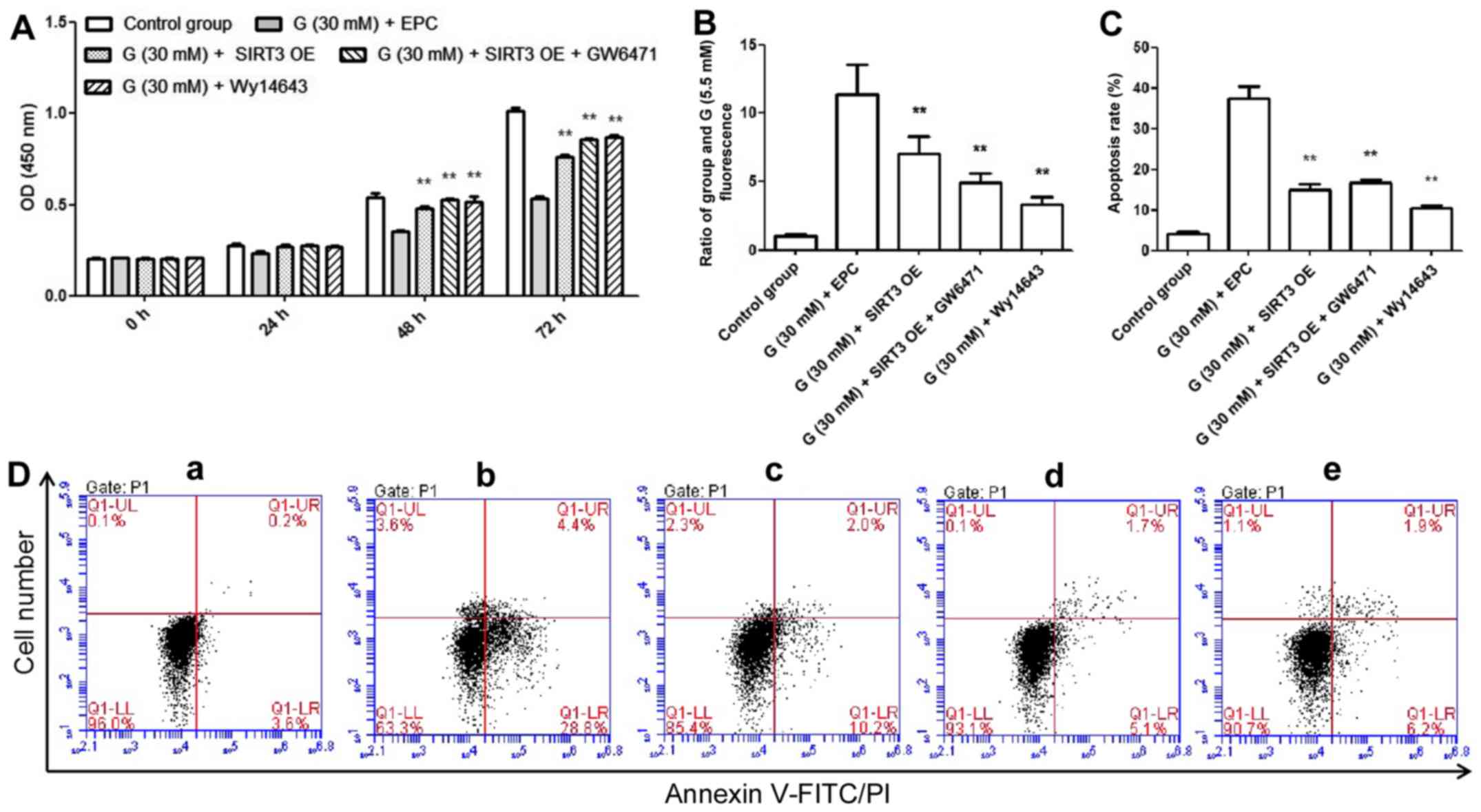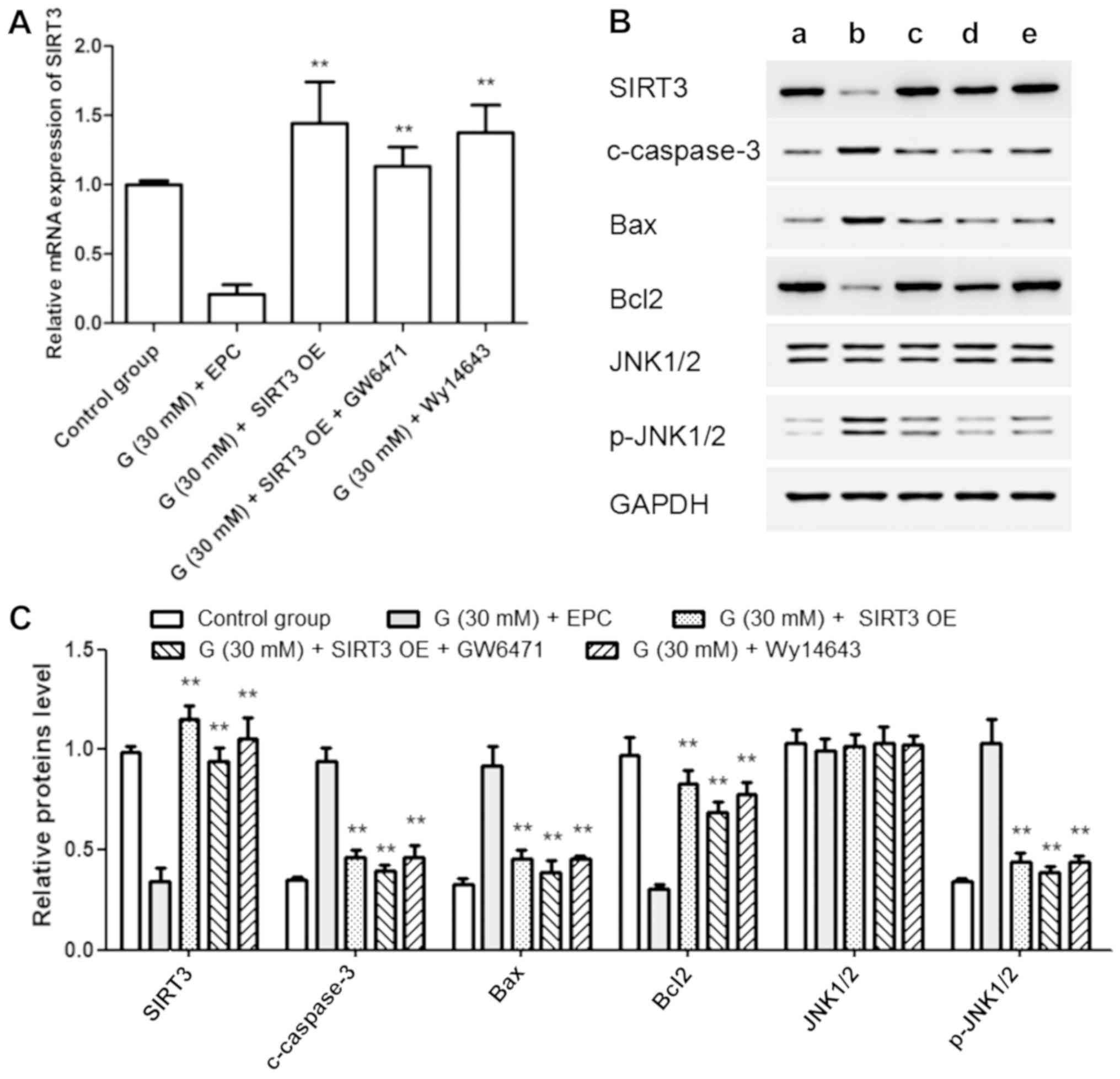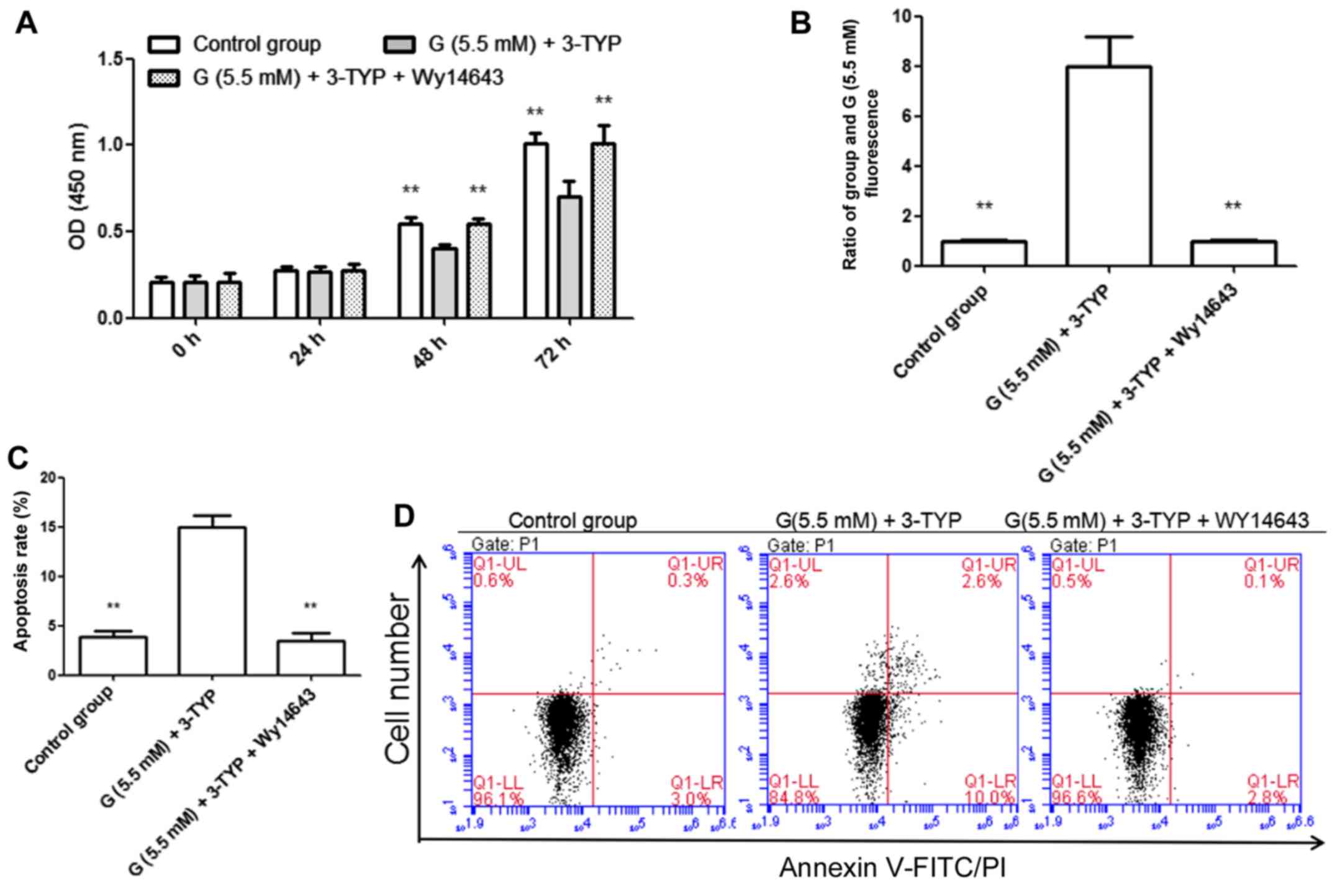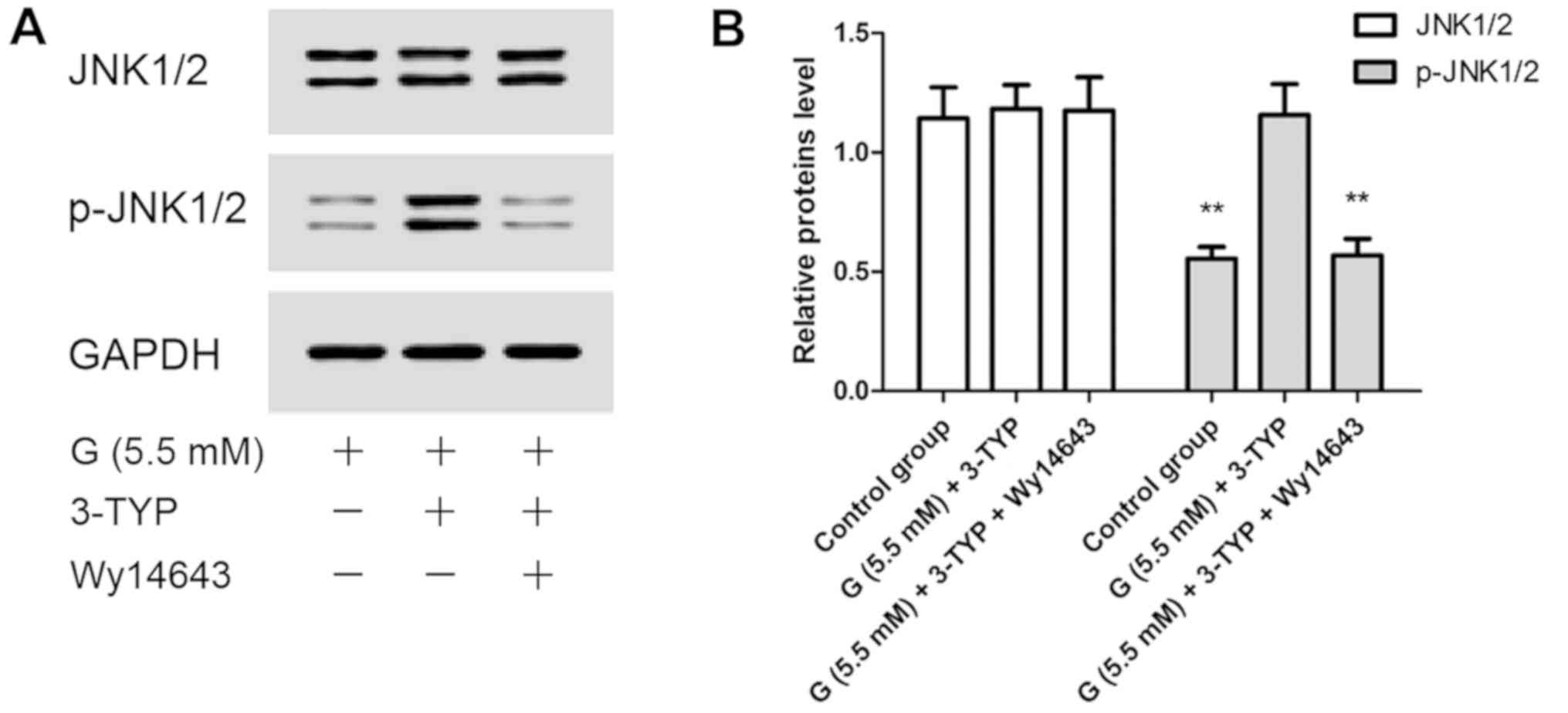SIRT3 is a downstream target of PPAR-α implicated in high glucose-induced cardiomyocyte injury in AC16 cells
- Authors:
- Published online on: June 10, 2020 https://doi.org/10.3892/etm.2020.8860
- Pages: 1261-1268
-
Copyright: © Zong et al. This is an open access article distributed under the terms of Creative Commons Attribution License.
Abstract
Introduction
Diabetes mellitus is a life-threatening and complex metabolic disorder affecting multiple systems in the body. The morbidity rate of diabetes in China is 9.7% and continues to grow (1). Diabetes is considered a major risk factor for coronary heart disease, with the mortality rate of cardiovascular disease in diabetic patients estimated at 65% (2). Diabetic cardiomyopathy (DCM) is a type of diabetic heart disease first discovered in 1972(3) and appears as myocardial dysfunction in diabetic patients without valvular heart disease, hypertension, or coronary artery disease (CAD) (3,4). Epidemiologic studies indicated that DCM was closely associated with progressive increase of relative wall thickness, left atrium and left ventricular mass and impaired glucose tolerance (4). Research on the etiopathogenesis of DCM revealed that hyperglycemia played a decisive role in the development of DCM (5).
Diabetes mellitus is characterized by several important changes in micro-vascular architecture, including subendothelial matrix deposition, abnormal capillary permeability, fibrosis surrounding arterioles and micro-aneurysm formation (6). Hyperglycemia can activate protein kinase C and stimulate vascular endothelial cells to enhance the production of vasoconstrictor prostanoids, which can promote endothelial dysfunction, as well as ventricular and myocardial hypertrophy (7,8). On the other hand, hyperglycemia also can aggravate intracellular oxidative stress, which then induces myocardial injury (9). Moreover, oxidative stress is exacerbated by reactive oxygen species (ROS) production in the mitochondria of diabetic cardiac tissues (10). Aberrant ROS production also increases pro-inflammatory response and myocardial apoptosis (11).
Peroxisome proliferator-activated receptors (PPARs) are important nuclear hormone receptors (12) consisting of 3 types (PPAR-α, PPAR-γ and PPAR-δ), each of which is encoded by separate genes and distinguished by specific ligands, functions, and distributions (12). A previous study described that transgenic mice with PPAR-α overexpression develop cardiomyopathy similar to the diabetes mellitus condition (13).
Acetylation is a critical mechanism for regulating the activity of widespread enzymes associated with mitochondrial metabolism, such as the fatty acid oxidation, citric acid cycle, antioxidant defense and the electron transport system (14-16). Sirtuin 3 (SIRT3) is the primary deacetylase in the mitochondria (17). Intriguingly, SIRT3 activity and expression were found to be decreased in an obesity animal model, possibly leading to obesity-related reduction of antioxidant defense and oxidative metabolism (18). However, very little is known about the function and mechanism of SIRT3 in DCM. In this study, the AC16 cell line was used as a cardiomyocyte model coupled with SIRT3 overexpression or inhibition (by 3-TYP), as well as treatment with PPAR-α agonist (Wy14643) or antagonist (GW6471) under high glucose/euglycemia conditions. The interaction between SIRT3 and PPAR-α was investigated.
Materials and methods
Chemicals and reagents
Glucose was from Sigma-Aldrich (Shanghai, China). Annexin V-FITC apoptosis detection kit, CCK8 assay kit and cellular reactive oxygen species detection kit were obtained from Beyotime Biotechnology. 3-TYP and Wy14643 were from Selleck Chemicals, and GW6471 from R&D Systems China. TRIzol reagent and reverse transcription kits were obtained from Thermo Fisher Scientific, Inc. PPAR-α antibody was from Abcam. SIRT3, cleaved caspase-3, Bax, Bcl2, JNK1/2, phosphorylated JNK1/2 (p-JNK1/2) and glyceraldehyde 3-phosphate dehydrogenase (GAPDH) antibodies were from Cell Signaling Technology.
The study was approved by the Ethics Committee of Central Hospital of Minhang District (Shanghai, China).
AC16 cells
AC16 human cardiomyocyte cell line was obtained from the Chinese Academy of Sciences Cell Bank (http://www.cellbank.org.cn/, Shanghai, China). Cells were incubated with DMEM media (HyClone) supplemented with 100 U/ml penicillin and 10% fetal bovine serum (FBS; Gibco; Thermo Fisher Scientific, Inc.) at 37˚C (5% CO2). AC16 cells at logarithmic phase were used for follow-up experiments.
Experimental groups
Effects of glucose treatment on SIRT3 and PPAR-α expression in AC16 cells. AC16 cells were treated with different concentrations of glucose (5.5, 10, 30 and 50 mM, added into glucose-free DMEM media) for 48 h. Relative mRNA expression and protein levels of SIRT3 and PPAR-α were detected at 24 and 48 h after treatment.
Effects of SIRT3 overexpression and PPAR-α activation/inhibition on AC16 cells under high glucose condition. AC16 cells were divided into 5 groups: Control group (5.5 mM glucose); G 30 mM + EPC group (30 mM glucose + empty plasmid control); G 30 mM + SIRT3 OE group (30 mM glucose + SIRT3 overexpression); G 30 mM + SIRT3 OE + GW6471 group (30 mM glucose + SIRT3 overexpression + PPAR-α antagonist, GW6471); and G 30 mM + Wy14643 group (30 mM glucose + PPAR-α agonist, Wy14643). First, glucose (5.5 or 30 mM) was added into glucose-free DMEM media in respective groups for 24 h. Then, SIRT3 OE or EPC lentivirus (JRDun Biotech) (Table I), Wy14643 (100 µM, dissolved in DMSO) and GW6471 (10 µM, dissolved in DMSO) were added into AC16 cells, respectively for 72 h. Proliferation of AC16 cells was examined at 0, 24, 48 and 72 h after lentivirus treatment. Cell apoptosis and reactive oxygen species levels were measured at the end of the experiment, along with SIRT3 mRNA expression and SIRT3, cleaved caspase-3, Bax, Bcl2, JNK1/2 and p-JNK1/2 protein levels.
Effects of SIRT3 inhibitor (3-TYP) and PPAR-α agonist (Wy14643) on AC16 cells under euglycemia condition. AC16 cells were divided into 3 groups, and received the following treatments: 5.5 mM glucose (control group); 5.5 mM glucose + 30 mM 3-TYP (G (5.5 mM) + 3-TYP group); and 5.5 mM glucose + 30 mM 3-TYP + 100 µM Wy14643 [G (5.5 mM) + 3-TYP + Wy14643 group]. AC16 cells in each group were treated with glucose (added into glucose-free DMEM media) for 24 h. Subsequently, the indicated chemicals were added and cells were cultured for 72 h. Proliferation of AC16 cells was assessed at 0, 24, 48 and 72 h after treatment. Cell apoptosis, reactive oxygen species levels, and JNK1/2 and p-JNK1/2 protein levels were examined at the end of the experiment.
Interaction between PPAR-α protein and SIRT3 promoter. Cells were treated with Wy14643 (100 µM), GW6471 (10 µM) or DMSO for 48 h. Chromatin immunoprecipitation (ChIP) and Dual-Lucy Assay kit (Promega, Beijing, China) were employed to test the interaction between PPAR-α and SIRT3.
Experimental methods
Cell proliferation and apoptosis assay. Cultured AC16 cells were harvested at relative time-points. Proliferation of AC16 cells was examined using CCK8 assay kit following the manufacturer's instructions. Cell absorbance was measured at 450 nm using a microplate reader (Thermo Fisher Scientific, Inc.).
Cultured AC16 cells were harvested and incubated with FITC-labelled Annexin V and PI at 25˚C for 20 min following the manufacturer's instructions. Subsequently, the intensity of Annexin V or PI fluorescence was analyzed by FACScan (Becton-Dickinson). For each sample, 10,000 cells were tested.
Dichlorodihydrofluorescein diacetate (DCFH-DA) flow cytometry. ROS production was assessed using DCFH-DA assay according to a previous study (19). Briefly, AC16 cells (106/ml) were cultured with 5 µM of 2'-7'-dichlorodihydrofluorescein diacetate (DCFH-DA) for 20 min at 37˚C (forward-reverse mixing once per 3 min). DCFH-DA (non-fluorescent) entered cells and hydrolyzed into cell-impermeable and non-fluorescent DCFH. DCFH was oxidized into highly fluorescent dichloroflurescein (DCF) by intracellular ROS. The green fluorescence intensity was proportional to ROS level. DCF fluorescence was assayed at 525 nm after excitation of cells at 480 nm using flow cytometry analysis (Becton-Dickinson). Results were expressed as the ratio of fluorescence intensity of AC16 cells in the other groups to that in control group.
ChIP and luciferase assay. ChIP is a powerful tool to investigate interactions between intracellular DNA and specific proteins, and detect their genomic localization (20). In the present study, interaction between PPAR-α protein and SIRT3 promoter was tested by ChIP assay according to a previous study (21). Briefly, cell samples were subjected to standard cross-linking, chromatin shearing, immunoprecipitation, reverse cross-linking, DNA precipitation and PCR analysis. The PCR products were determined using semi-quantitative RT-PCR (primers are shown in Table I).
Cells were co-transfected with a dual-luciferase reporter plasmid containing SIRT3 promoter-reporter plasmid (JRDun Biotech), in combination with Wy14643 or GW6471 treatment for 48 h in 24-well plates. Luciferase activity was measured using the Dual-Lucy Assay Kit (Promega) following the manufacturer's protocol (primers are shown in Table I).
RT-qPCR. Relative mRNA expression was determined by RT-qPCR. Total mRNA was isolated using TRIzol, and 2 µg of total RNA from each sample was reverse transcribed into cDNA using First Strand cDNA Synthesis kit (Thermo Fisher Scientific, Inc.) on RT-qPCR machine (ABI-7300; Applied Biosystems).
Primers used for the RT-qPCR are shown in Table II. Relative mRNA expression was evaluated by 2-ΔΔCt relative quantitative analysis against GAPDH.
Western blot analysis. Total protein from each sample was extracted, and protein concentration was measured using BCA protein assay kit. Protein (30 µg) was separated by 10% SDS-PAGE and transferred onto PVDF membranes, which were then blocked in 5% skimmed milk at 25˚C for 1 h, followed by incubation with primary antibodies overnight at 4˚C. After washing, membranes were incubated with secondary antibodies for 1 h. Finally, protein bands were visualized using ECL-detection kit (Beyotime Biotechnology). The following primary antibodies were used: PPAR-α (1:1,000), SIRT3 (1:1,000), cleaved caspase-3 (1:1,000), Bax (1:1,000), Bcl2 (1:1,000), JNK1/2 (1:1,000), p-JNK1/2 (1:1,000) and GAPDH (1:1,000; CST). GAPDH served as a loading control.
Statistical analysis
Data were expressed as mean ± SD (n=3). Difference was evaluated using ANOVA. Ducan multiple range test was determined using SPSS 20.0 software (IBM Corp). P<0.05 was considered as statistically significant.
Results
Glucose treatment downregulates expression of SIRT3 and PPAR-α in AC16 cells
In the current study, both mRNA expression and protein levels of SIRT3 and PPAR-α in AC16 cells showed no change with time under euglycemia condition (5.5 mM of glucose). However, with increasing dose (≥30 mM), SIRT3 and PPAR-α mRNA expression (Fig. 1A and B) and protein levels (Fig. 1C-E) were reduced, and further diminished over time (Fig. 1).
Effects of SIRT3 OE and PPAR-α activation/inhibition on AC16 cells under high glucose (30 mM) condition
The regulatory function of SIRT and whether it was regulated by PPAR-α under high glucose (30 mM) condition were investigated. The present results indicated that the proliferation of AC16 cells was inhibited by high glucose (30 mM) treatment at 48 h (34.67±3.21%) and 72 h (47.13±5.42%), but was antagonized by SIRT3 OE, SIRT3 OE + GW6471 and Wy14643 treatment (Fig. 2A). Moreover, intracellular hydrogen peroxide production and apoptosis were induced by glucose (30 mM) treatment for 72 h, but reduced by SIRT3 OE, SIRT3 OE + GW6471 and Wy14643 treatment (Fig. 2B-D). In addition, SIRT3 mRNA expression and protein level were diminished by high glucose (30 mM) but increased by SIRT3 OE, SIRT3 OE + GW6471 and Wy14643 treatment (Fig. 3A-C). Moreover, the protein levels of cleaved caspase-3, Bax and p-JNK1/2 displayed trends consistent with apoptosis, whereas Bcl2 protein level showed a trend opposite to Bax. These results suggested that SIRT3 might be positively regulated by PPAR-α in AC16 cells (Fig. 3B and C).
Effects of 3-TYP and Wy14643 treatments on AC16 cells under euglycemia condition
Based on the above findings, it was hypothesized that the downregulation of SIRT3 might play an important role during the process of high glucose-induced myocardial injury. Therefore, the effects of 3-TYP and Wy14643 treatments on AC16 cells under euglycemia condition were analyzed. In the present study, the inhibition of SIRT3 (by treatment with 3-TYP) in AC16 cells led to similar results under euglycemia condition as high glucose treatment, including inhibition of cell proliferation (Fig. 4A), stimulation of intracellular hydrogen peroxide production and induction of apoptosis (Fig. 4B-D), and increased phosphorylation of JNK1/2. Furthermore, these phenomena could be relieved by activation of PPAR-α (Fig. 5A and B).
SIRT3 is a direct, positively regulated target of PPAR-α
The intracellular interaction between SIRT3 promoter and PPAR-α was tested using ChIP and luciferase assay. The present results suggested that intracellular PCR production of SIRT3 promoter was increased by PPAR-α agonist and decreased by PPAR-α antagonist (Fig. 6A and B). Furthermore, the ratio of Firefly and Renilla luciferase signals showed similar trends (Fig. 6C).
Discussion
DCM has become a worldwide public health concern, yet the mechanisms and occurrence of DCM remain unknown (2,5). Herein, it was found that abnormally low expression of SIRT3 may play an important role in DCM. SIRT3 expression was weakened under high glucose condition in AC16 cells. Whereas, high glucose inhibited proliferation of AC16 cells and enhanced apoptosis and intracellular hydrogen peroxide production. These phenomena could be improved by SIRT3 overexpression. SIRT3 inhibition led to similar phenomena in AC16 cells under euglycemia condition as under high glucose treatment.
The production of ROS is considered to be a contributing factor in the occurrence and progression of diabetic cardiomyopathy (22). The strategy of enhancing mitochondrial ROS scavenge system has been clinically proven to be effective in reducing cardiac dysfunction caused by diabetes (22). SIRT3 plays a key role in improving mitochondrial dysfunction and oxidative stress via the MAPK pathway (23,24). SIRT3 is able to maintain ROS homeostasis by regulating diverse mitochondrial enzymes, including superoxide dismutase 2 (SOD2), which can transform harmful superoxide free radicals into non-toxic hydrogen peroxide or oxygen (25). In the present study, ROS production was negatively correlated with SIRT3 expression, which may be related to the downregulation of JNK1/2 phosphorylation.
PPAR-α is a member of PPAR nuclear transcription factor family that is enriched in myocardium (26). PPAR-α maintains antioxidant defense and oxidant equilibrium, and exhibits anti-inflammatory action (26). PPAR-α also plays a crucial role in the regulation of lipoprotein transport and assembly, as well as mitochondrial fatty acid oxidation (27). Decrease in PPAR-α expression has been suggested to be a self-adaptation process that transforms the metabolic substrate of cardiac energy from fatty acid to glucose (28). It was found in this study that PPAR-α expression was downregulated in AC16 cells under high glucose condition. Furthermore, PPAR-α agonists improved myocardial cell injury induced by high glucose. Results from ChIP and luciferase assay attested that SIRT3 was a direct, positively regulated target of PPAR-α.
In conclusion, the present results indicated that diminished expression of SIRT3 played an important role during high glucose-induced injury in AC16 cells. The function of SIRT3 and its interaction with PPAR-α were further evaluated in AC16 cells, and the results demonstrated that SIRT3 was a downstream target of PPAR-α.
Acknowledgements
Not applicable.
Funding
This study was supported by Science and Technology Committee of Minhang District, Shanghai (grant no. 2017MHZ72).
Availability of data and materials
The datasets used and/or analyzed during the present study are available from the corresponding author on reasonable request.
Authors' contributions
XZ contributed to the conception and design of the study, supervised the progress of individual study experiments and wrote the manuscript. KC and GY performed cell proliferation and apoptosis assay and flow cytometry. ZW, QS and DY were responsible for RT-qPCR and western blot analysis. PL, WH and YC contributed to observation indexes analysis. The final version was read and adopted by all the authors. All authors read and approved the final manuscript.
Ethics approval and consent to participate
The study was approved by the Ethics Committee of Central Hospital of Minhang District (Shanghai, China).
Patient consent for publication
Not applicable.
Competing interests
The authors declare that they have no competing interests.
References
|
Li D, Han N and Cui Z: Application of latent class model in the classification of the patients with diabetes vulnerability. Chin J Health Stat. 1:11–13. 2018. | |
|
Pappachan JM, Varughese GI, Sriraman R and Arunagirinathan G: Diabetic cardiomyopathy: Pathophysiology, diagnostic evaluation and management. World J Diabetes. 4:177–189. 2013.PubMed/NCBI View Article : Google Scholar | |
|
Rubler S, Dlugash J, Yuceoglu YZ, Kumral T, Branwood AW and Grishman A: New type of cardiomyopathy associated with diabetic glomerulosclerosis. Am J Cardiol. 30:595–602. 1972.PubMed/NCBI View Article : Google Scholar | |
|
Rutter MK, Parise H, Benjamin EJ, Levy D, Larson MG, Meigs JB, Nesto RW, Wilson PW and Vasan RS: Impact of glucose intolerance and insulin resistance on cardiac structure and function: Sex-related differences in the Framingham Heart Study. Circulation. 107:448–454. 2003.PubMed/NCBI View Article : Google Scholar | |
|
Aneja A, Tang WH, Bansilal S, Garcia MJ and Farkouh ME: Diabetic cardiomyopathy: Insights into pathogenesis, diagnostic challenges, and therapeutic options. Am J Med. 121:748–757. 2008.PubMed/NCBI View Article : Google Scholar | |
|
Rossen JD: Abnormal microvascular function in diabetes: Relationship to diabetic cardiomyopathy. Coron Artery Dis. 7:133–138. 1996.PubMed/NCBI View Article : Google Scholar | |
|
Hattori Y, Kawasaki H, Abe K and Kanno M: Superoxide dismutase recovers altered endothelium-dependent relaxation in diabetic rat aorta. Am J Physiol. 261:H1086–H1094. 1991.PubMed/NCBI View Article : Google Scholar | |
|
Bucala R, Tracey KJ and Cerami A: Advanced glycosylation products quench nitric oxide and mediate defective endothelium-dependent vasodilatation in experimental diabetes. J Clin Invest. 87:432–438. 1991.PubMed/NCBI View Article : Google Scholar | |
|
Tarquini R, Lazzeri C, Pala L, Rotella CM and Gensini GF: The diabetic cardiomyopathy. Acta Diabetol. 48:173–181. 2011.PubMed/NCBI View Article : Google Scholar | |
|
Huynh K, Bernardo BC, McMullen JR and Ritchie RH: Diabetic cardiomyopathy: Mechanisms and new treatment strategies targeting antioxidant signaling pathways. Pharmacol Ther. 142:375–415. 2014.PubMed/NCBI View Article : Google Scholar | |
|
Cai L, Li W, Wang G, Guo L, Jiang Y and Kang YJ: Hyperglycemia-induced apoptosis in mouse myocardium: Mitochondrial cytochrome C-mediated caspase-3 activation pathway. Diabetes. 51:1938–1948. 2002.PubMed/NCBI View Article : Google Scholar | |
|
Dreyer C, Krey G, Keller H, Givel F, Helftenbein G and Wahli W: Control of the peroxisomal beta-oxidation pathway by a novel family of nuclear hormone receptors. Cell. 68:879–887. 1992.PubMed/NCBI View Article : Google Scholar | |
|
Finck BN, Lehman JJ, Leone TC, Welch MJ, Bennett MJ, Kovacs A, Han X, Gross RW, Kozak R, Lopaschuk GD, et al: The cardiac phenotype induced by PPARalpha overexpression mimics that caused by diabetes mellitus. J Clin Invest. 109:121–130. 2002.PubMed/NCBI View Article : Google Scholar | |
|
Finley LWS, Haas W, Desquiret-Dumas V, Wallace DC, Procaccio V, Gygi SP and Haigis MC: Succinate dehydrogenase is a direct target of sirtuin 3 deacetylase activity. PLoS One. 6(e23295)2011.PubMed/NCBI View Article : Google Scholar | |
|
Qiu X, Brown K, Hirschey MD, Verdin E and Chen D: Calorie restriction reduces oxidative stress by SIRT3-mediated SOD2 activation. Cell Metab. 12:662–667. 2010.PubMed/NCBI View Article : Google Scholar | |
|
Tao R, Coleman MC, Pennington JD, Ozden O, Park SH, Jiang H, Kim HS, Flynn CR, Hill S, Hayes McDonald W, et al: Sirt3-mediated deacetylation of evolutionarily conserved lysine 122 regulates MnSOD activity in response to stress. Mol Cell. 40:893–904. 2010.PubMed/NCBI View Article : Google Scholar | |
|
Lombard DB, Alt FW, Cheng HL, Bunkenborg J, Streeper RS, Mostoslavsky R, Kim J, Yancopoulos G, Valenzuela D, Murphy A, et al: Mammalian Sir2 homolog SIRT3 regulates global mitochondrial lysine acetylation. Mol Cell Biol. 27:8807–8814. 2007.PubMed/NCBI View Article : Google Scholar | |
|
Kendrick AA, Choudhury M, Rahman SM, McCurdy CE, Friederich M, Van Hove JL, Watson PA, Birdsey N, Bao J, Gius D, et al: Fatty liver is associated with reduced SIRT3 activity and mitochondrial protein hyperacetylation. Biochem J. 433:505–514. 2011.PubMed/NCBI View Article : Google Scholar | |
|
Caldefie-Chézet F, Walrand S, Moinard C, Tridon A, Chassagne J and Vasson MP: Is the neutrophil reactive oxygen species production measured by luminol and lucigenin chemiluminescence intra or extracellular? Comparison with DCFH-DA flow cytometry and cytochrome c reduction. Clin Chim Acta. 319:9–17. 2002.PubMed/NCBI View Article : Google Scholar | |
|
Gilmour DS and Lis JT: RNA polymerase II interacts with the promoter region of the noninduced hsp70 gene in Drosophila melanogaster cells. Mol Cell Biol. 6:3984–3989. 1986.PubMed/NCBI View Article : Google Scholar | |
|
Us-Camas R and De-la-Peña C: Chromatin immunoprecipitation (ChiP) protocol for the analysis of gene regulation by histone modifications in Agave angustifolia haw. Methods Mol Biol. 1815:371–383. 2018.PubMed/NCBI View Article : Google Scholar | |
|
Cai L, Wang Y, Zhou G, Chen T, Song Y, Li X and Kang YJ: Attenuation by metallothionein of early cardiac cell death via suppression of mitochondrial oxidative stress results in a prevention of diabetic cardiomyopathy. J Am Coll Cardiol. 48:1688–1697. 2006.PubMed/NCBI View Article : Google Scholar | |
|
Zheng J, Shi L, Liang F, Xu W, Li T, Gao L, Sun Z, Yu J and Zhang J: Sirt3 ameliorates oxidative stress and mitochondrial dysfunction after intracerebral hemorrhage in diabetic rats. Front Neurosci. 12(414)2018.PubMed/NCBI View Article : Google Scholar | |
|
Wang G, Fu XL, Wang JJ, Guan R, Sun Y and Tony To SS: Inhibition of glycolytic metabolism in glioblastoma cells by Pt3glc combinated with PI3K inhibitor via SIRT3-mediated mitochondrial and PI3K/Akt-MAPK pathway. J Cell Physiol. 234:5888–5903. 2019.PubMed/NCBI View Article : Google Scholar | |
|
Bause AS and Haigis MC: SIRT3 regulation of mitochondrial oxidative stress. Exp Gerontol. 48:634–639. 2013.PubMed/NCBI View Article : Google Scholar | |
|
Lee TI, Kao YH, Chen YC, Huang JH, Hsiao FC and Chen YJ: Peroxisome proliferator-activated receptors modulate cardiac dysfunction in diabetic cardiomyopathy. Diabetes Res Clin Pract. 100:330–339. 2013.PubMed/NCBI View Article : Google Scholar | |
|
Desvergne B and Wahli W: Peroxisome proliferator-activated receptors: Nuclear control of metabolism. Endocr Rev. 20:649–688. 1999.PubMed/NCBI View Article : Google Scholar | |
|
Barger PM and Kelly DP: PPAR signaling in the control of cardiac energy metabolism. Trends Cardiovasc Med. 10:238–245. 2000.PubMed/NCBI View Article : Google Scholar |



